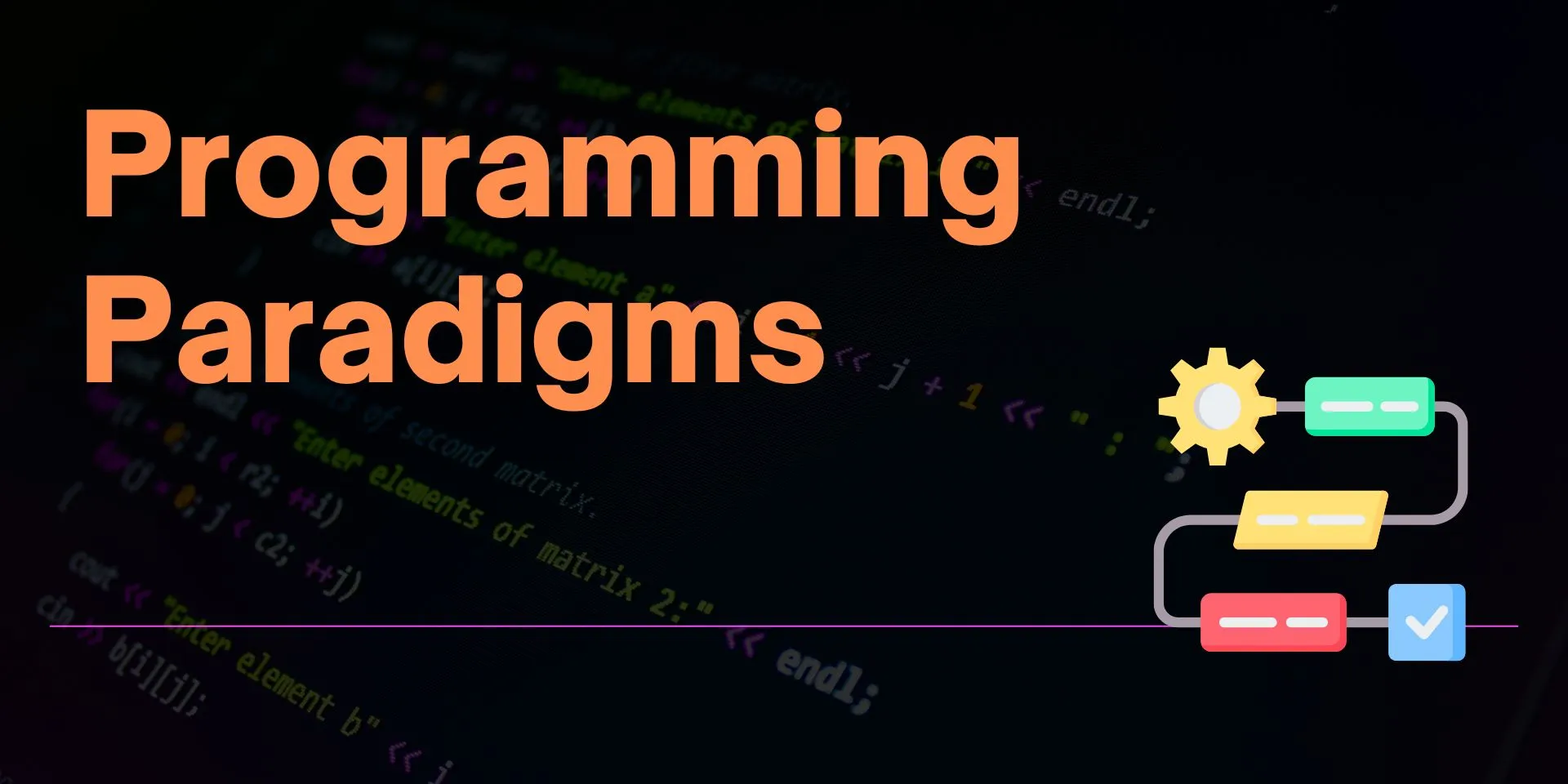Programming paradigms are different approaches or styles of programming that provide a set of principles, concepts, and practices to solve computational problems. A programming paradigm defines the way in which a programmer structures and organizes code to build software applications.
There are several programming paradigms, including: Object-Oriented Programming (OOP), , Functional Programming (FP), Logic Programming: Logic programming, Aspect-Oriented Programming (AOP), Event-Driven Programming (EDP), among others.
Difference of Imperative and Declarative Programming Paradigms
Programming paradigms can be classified into two main categories: imperative and declarative.
Imperative programming is a programming paradigm that focuses on describing how to solve a problem step by step using a sequence of instructions or statements. It typically involves explicit manipulation of program state and is concerned with the control flow of the program. Imperative programming languages include C, C++, Java, Python, and others.
Declarative programming, on the other hand, is a programming paradigm that focuses on what to do, rather than how to do it. In declarative programming, the programmer specifies a set of constraints, properties, or rules that describe the problem, and leaves it to the system to find a solution that satisfies those constraints. Declarative programming is often associated with higher-level programming languages that use domain-specific languages, data-driven or rule-based systems, or functional programming. Examples of declarative programming languages include SQL, Prolog, Haskell, and JavaScript (when used in a functional style).
Based on these categories, different programming paradigms can be classified as either imperative or declarative.
Imperative programming include:
- Procedural Programming
- Object-Oriented Programming (OOP)
- Event-Driven Programming (EDP)
- Imperative Dataflow Programming
- Imperative Parallel Programming
There are also other programming paradigms that can be seen as a type of imperative programming, such as structured programming, which uses control structures such as loops and conditionals to organize code, or imperative reactive programming, which combines imperative and reactive programming to handle complex event-driven scenarios.
Declarative programming include:
- Functional Programming (FP)
- Logic Programming
- Constraint Programming
- Declarative Dataflow Programming
- Rule-based Programming
There are also other programming paradigms that can be seen as a type of declarative programming, such as reactive programming, which uses data streams and event propagation to handle complex event-driven scenarios, or data-oriented programming, which emphasizes the manipulation of data structures rather than the computation.
Imperative Programming Paradigm
Imperative programming is a programming paradigm that focuses on describing how to solve a problem step by step using a sequence of instructions or statements. Imperative programming is widely used in software development and is supported by most programming languages, including C, C++, Java, Python, and others.
The primary advantage of using imperative programming is that it provides a high level of control over the behavior and state of the program. It allows the programmer to specify the exact sequence of operations to be performed, as well as the conditions under which they are executed. This level of control can be particularly useful in low-level programming, such as system programming, where performance and efficiency are critical.
Imperative programming is also well-suited to applications that require a lot of input/output (I/O) operations or interactions with the user, such as user interfaces or network programming. Imperative programming allows the programmer to define event-driven behavior that can respond to user actions or system events in real-time.
However, there are also some disadvantages to using imperative programming. Imperative code can be verbose and difficult to read and maintain, especially in larger codebases. Imperative code can also be prone to errors and bugs, particularly when dealing with mutable state, concurrency, or low-level operations.
Additionally, imperative programming can be less modular and less reusable than other programming paradigms, such as functional programming. Imperative code is often organized around control flow, which can make it difficult to extract and reuse individual functions or modules.
Procedural Programming
Procedural programming is a programming paradigm that uses procedures, subroutines, or functions to organize code into modular and reusable units. The main idea behind procedural programming is to break down a program into a set of smaller procedures, each of which is responsible for performing a specific task.
The primary advantage of using procedural programming is that it can lead to more modular and reusable code. By organizing code into procedures, the programmer can more easily isolate and debug errors, as well as reuse common code across the program. Procedural programming can also be more efficient than other programming paradigms, particularly for low-level system programming, because it allows for direct control over the machine.
Procedural programming is particularly well-suited for solving problems that can be expressed as a sequence of steps, such as mathematical computations or simple data processing tasks. It is also commonly used in system programming, where direct access to the machine is often necessary.
A disadvantage of it is that Procedural code can be verbose and difficult to read, particularly as the size of the program grows. The lack of encapsulation in procedural programming can make it harder to maintain and test, particularly when changes need to be made to a particular procedure.
In summary, procedural programming is a useful programming paradigm for applications that involve a sequence of steps or require low-level system access. It can provide more modular and efficient code, but is often less maintainable and readable than other programming paradigms. Procedural programming is often used in conjunction with other programming paradigms, such as object-oriented programming or functional programming, to build complex and maintainable software systems.
Object Oriented Programming
Object-oriented programming (OOP) is a programming paradigm that is based on the concept of objects, which are instances of classes that encapsulate data and behavior. OOP is a popular programming paradigm that has been used in many applications, including desktop and mobile software, video games, and web development.
The main idea behind OOP is to organize code into modular and reusable units, which are based on real-world concepts and behaviors. These units are called classes, and they define the properties (data) and methods (behavior) of objects. Objects are created from classes and can interact with each other to perform tasks or exchange information.
To go deeper and learn Object Oriented Programming OOP, start with this introductory article and then follow the Object Oriented Programming (OOP) course in this site.
Event-driven Programming
Event-driven programming is a programming paradigm that responds to user actions or system events by triggering callbacks or listeners that handle the events. This approach is commonly used in graphical user interfaces (GUIs) and network programming, where a program must respond to a wide variety of user inputs or network events.
The primary advantage of using event-driven programming is that it provides a more responsive and interactive user experience. By using callbacks or listeners, the program can be designed to react to events in real-time, without the need for polling or other time-consuming techniques. This can be particularly useful in GUIs, where users expect a fast and intuitive response to their actions.
Another advantage of event-driven programming is that it can simplify the design of complex systems. By focusing on events and the reactions to those events, the programmer can break down a complex system into a set of smaller and more manageable pieces. This can result in more modular and maintainable code, which can reduce the time and cost of development.
One problem when using Event-driven is that the code can be more difficult to understand and debug, particularly as the number of events and callbacks grows. The lack of a clear control flow can make it harder to follow the execution of the program, and can result in unexpected or hard-to-find errors.
Another potential disadvantage of event-driven programming is that it can lead to the creation of a large number of small and tightly-coupled functions or objects, which can make the code harder to maintain and test. It is important to carefully design the architecture of an event-driven program to avoid these issues.
In summary, event-driven programming is a useful programming paradigm for applications that require a high level of interactivity and responsiveness, such as graphical user interfaces. It can provide a more intuitive and user-friendly experience, as well as more modular and maintainable code. However, it is important to be aware of the potential disadvantages of using event-driven programming, such as the difficulty of debugging and maintaining complex event-driven code.
Imperative Dataflow Programming
Imperative dataflow programming is a programming paradigm that combines the concepts of imperative programming and dataflow programming. In this paradigm, the programmer specifies a set of data dependencies, and the program automatically determines the order in which the data is processed.
The main idea behind imperative dataflow programming is to separate the data from the control flow, allowing for more flexible and modular code. Instead of specifying the order in which operations are executed, the programmer specifies the relationships between the data elements, and the program automatically determines the most efficient way to process the data.
Imperative Parallel Programming
Imperative parallel programming is a programming paradigm that focuses on executing code simultaneously across multiple processing units. It is used to speed up the execution of programs that involve a large amount of computation or data processing, by distributing the workload across multiple processing units.
The main idea behind imperative parallel programming is to break down a program into smaller, independent units of computation, and then execute these units simultaneously across multiple processing units. This can be done using shared memory, distributed memory, or message passing, depending on the architecture of the system.
The primary advantage of using imperative parallel programming is that it can significantly improve the performance and efficiency of a program. By distributing the workload across multiple processing units, the program can take advantage of the available processing power, and can perform calculations much faster than a serial program.
Another advantage of imperative parallel programming is that it can lead to more scalable and flexible code. By breaking down a program into smaller units of computation, the code can be more easily parallelized, which can make it easier to scale the program as the size of the problem or the amount of available processing power increases.
However, the increasing of number of processing units and complexity of the program can lead to more synchronization overhead, which can reduce the overall performance of the program.
In summary, imperative parallel programming is a useful programming paradigm for applications that require a high degree of computational power, such as scientific simulations or machine learning algorithms. It can provide significant performance benefits and can be used in conjunction with other programming paradigms, such as object-oriented programming or functional programming. However, it is important to be aware of the potential disadvantages of using imperative parallel programming, such as the increased complexity of the code and the difficulty of debugging parallel programs.
Aspect Oriented Programming Paradigm (AOP)
Aspect-Oriented Programming (AOP) is a programming paradigm that aims to improve the modularity and maintainability of software by separating cross-cutting concerns from the main logic of the program. Cross-cutting concerns are features of a program that affect multiple modules or components, such as logging, security, or error handling. These concerns can often lead to code duplication and make it harder to maintain and modify software over time.
In AOP, cross-cutting concerns are extracted into separate modules called “aspects”, which are then woven into the main code of the program. Aspects can modify the behavior of the program at runtime, without requiring changes to the main logic. This makes it easier to add, remove, or modify cross-cutting concerns, and can improve the maintainability of the software.
AOP is often used in combination with other programming paradigms, such as Object-Oriented Programming (OOP). In fact, AOP can be seen as a complementary paradigm to OOP, since it can help to address some of the limitations of OOP, such as code duplication and maintenance issues. AOP is used in many programming languages, including Java, Python, and C++, and has become an important tool for software development.
Declarative Programming Paradigm
Declarative programming is a programming paradigm that focuses on describing what the program should accomplish, rather than how it should be accomplished. Declarative programming languages use declarative statements to specify the problem to be solved, and the language runtime or interpreter figures out how to solve the problem.
The primary advantage of using declarative programming is that it can be more concise and easier to understand than imperative programming. Because the programmer is not specifying every step of the process, the code can be easier to read and maintain. Declarative programming is particularly useful for complex problems that are difficult to express in a procedural or imperative way, such as complex data queries or optimization problems.
Another advantage of declarative programming is that it can be more modular and more reusable than imperative programming. Declarative code is often organized around the data and the relationships between data, which can make it easier to extract and reuse individual functions or modules. This can result in more maintainable code and faster development cycles.
However, there are also some disadvantages to using declarative programming. Declarative code can be less efficient than imperative code, particularly for problems that involve a lot of low-level operations or a large amount of data. Declarative code can also be less flexible than imperative code, as the programmer does not have full control over the execution of the program.
In summary, declarative programming is a useful programming paradigm for applications that involve complex problems and data queries. It can provide more concise and maintainable code, and is often used in conjunction with other programming paradigms, such as functional programming or logic programming. However, it is important to be aware of the potential disadvantages of using declarative programming, such as decreased efficiency and flexibility, particularly for problems that involve a large amount of data or low-level operations.
Functional Programming
Functional programming is a programming paradigm that is based on the concept of mathematical functions. In functional programming, functions are treated as first-class objects, which means they can be passed as arguments to other functions, returned as values, and stored in data structures. Functional programming emphasizes immutable data and avoids side effects, such as changes to global state or input/output operations.
The main idea behind functional programming is to avoid changing state and instead focus on the computation of values based on their inputs. This can lead to more modular and reusable code, as functions can be combined and reused to solve a variety of problems.
The primary advantage of using functional programming is that it can lead to more concise and readable code. By focusing on the computation of values based on inputs, the code can be more easily understood and maintained. The emphasis on immutable data also leads to more predictable and less error-prone code.
Another advantage of functional programming is that it can be more suitable for parallel and concurrent programming, as functions are designed to operate on independent data and avoid side effects. This can make it easier to write code that can take advantage of multiple processing units and improve performance.
However, the emphasis on immutability can make some tasks, such as input/output or certain types of data processing, more difficult to express. The functional programming paradigm can also be less suitable for certain types of problems, such as those that require mutable state or complex control flow.
In summary, functional programming is a useful programming paradigm for applications that require modularity, readability, and predictability, such as mathematical computations or data processing tasks. It can provide more concise and maintainable code, and can be used in conjunction with other programming paradigms, such as object-oriented programming or imperative programming, to build complex and maintainable software systems. However, it is important to be aware of the potential disadvantages of using functional programming, such as the difficulty of expressing certain types of tasks, and the potential mismatch with certain types of problems.
Logic Programming
Logic programming is a programming paradigm that is based on the concept of logic and rules. In logic programming, the program is written as a set of logical statements, and the execution of the program involves searching for a solution that satisfies the constraints defined by these statements.
The main idea behind logic programming is to express a problem in terms of logical constraints and let the program find a solution that satisfies these constraints. This can lead to more declarative and natural problem-solving, as the program is focused on what needs to be accomplished, rather than how to accomplish it.
The primary advantage of using logic programming is that it can be more suitable for problems that involve complex reasoning or search, such as artificial intelligence or expert systems. By expressing a problem in terms of logical constraints, the program can more easily explore the search space and find a solution that satisfies the constraints.
Another advantage of logic programming is that it can be more declarative and easier to read and understand. The program is written in terms of logical rules and constraints, which can make it easier to reason about and maintain.
However, there are also some disadvantages to using logic programming. The search space for a problem can be very large, which can make the program slow and inefficient. The need to search for a solution can also make the program difficult to parallelize, which can limit its performance.
Another potential disadvantage of logic programming is that it can be less suitable for problems that require mutable state or complex control flow, as these features are not easily expressed in terms of logical constraints.
In summary, logic programming is a useful programming paradigm for applications that involve complex reasoning or search, such as artificial intelligence or expert systems. It can provide a more declarative and natural approach to problem-solving, and can be used in conjunction with other programming paradigms, such as functional programming or imperative programming. However, it is important to be aware of the potential disadvantages of using logic programming, such as the potential inefficiency of searching for a solution, and the potential limitations on mutable state and control flow.
Are low code and no code considered types of programming paradigms ?
Low code and no code are not considered programming paradigms, but rather development approaches or methodologies that aim to reduce the amount of code that needs to be written to create software applications.
Low code development involves using a visual development environment with pre-built components, drag-and-drop interfaces, and declarative programming constructs to create software applications. Low code platforms often provide built-in connectors to integrate with other systems and services, as well as tools to automate testing, deployment, and maintenance. Low code development is intended to reduce the time and cost of software development by enabling non-technical users to build applications without having to write complex code.
No code development, on the other hand, is an even more abstracted approach that eliminates the need for coding altogether. No code platforms provide a graphical interface or natural language input to create applications, often using a combination of machine learning, artificial intelligence, and pre-built components. No code development is intended to allow users with no technical knowledge to create software applications.
While low code and no code development can be seen as alternative approaches to traditional programming, they do not represent a new programming paradigm or a replacement for existing paradigms. Instead, they are designed to simplify the development process by abstracting away some of the technical details and allowing users to focus on the problem domain and the user experience.
Conclusion
It is important to know the different programming paradigms because this offer different ways of thinking about how approaching programming problems. By understanding the strengths and weaknesses of each paradigm, a programmer can choose the best approach for a particular problem, leading to more efficient and effective solutions.
In addition, different paradigms can be used in conjunction with each other to create more powerful and flexible software systems. For example, object-oriented programming can be combined with functional programming to create a system that is both modular and maintainable, as well as highly performant.
By understanding a variety of paradigms, a programmer can more easily learn new programming languages and frameworks, as well as adopt new technologies and methodologies as they arise.





Comments